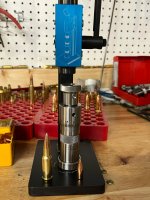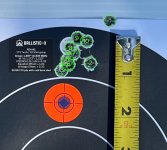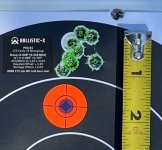stagpanther
New member
By sheer coincidence, I just got back from shooting my savage axis build that I re-barreled from 6BR to 30BR. I think the 30BR is quite possibly the most accurate shorter range cartridge ever designed, possibly even more so than the 6PPC. Having enough experience with the 30 BR, I knew in advance there was no way I could miss shooting 10 shots under MOA unless I really goofed up--which in fact I came pretty close to doing.  I shot these at 173 yards with a moderate crosswind of 10 mph +/- I used berger 115 target bullets propelled by H4198. As with previous attempts I shot 10 shots only with no sighters/foulers and in this case, the very first cold and clean bore shot is the one that landed high and right. My 25 creedmoor's first shots tended to land low and walk up--whereas the 30 BR landed high and tended to walk low.
I shot these at 173 yards with a moderate crosswind of 10 mph +/- I used berger 115 target bullets propelled by H4198. As with previous attempts I shot 10 shots only with no sighters/foulers and in this case, the very first cold and clean bore shot is the one that landed high and right. My 25 creedmoor's first shots tended to land low and walk up--whereas the 30 BR landed high and tended to walk low.

Here is the group scored including the clean/cold bore shot, which still came in a bit under MOA:

Here is the same group scored without the first cold/clean bore:

As nice as that group might look, I actually called 3 fliers as the shots broke because I could see that I pulled them. It may sound like sensationalistic BS; but ask any comp shooter who has experience with the 30 BR and I'm sure they would agree that even this level of accuracy/consistency would not be competitive.
That's how good the 30 BR is.
Here is the group scored including the clean/cold bore shot, which still came in a bit under MOA:
Here is the same group scored without the first cold/clean bore:
As nice as that group might look, I actually called 3 fliers as the shots broke because I could see that I pulled them. It may sound like sensationalistic BS; but ask any comp shooter who has experience with the 30 BR and I'm sure they would agree that even this level of accuracy/consistency would not be competitive.
That's how good the 30 BR is.
Attachments
Last edited:



